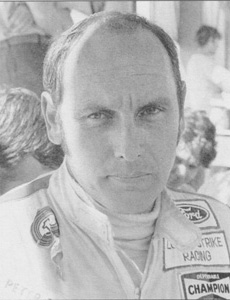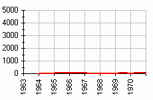Гонщики, K | |
Klerk, Peter de Курсивом отмечены гонщики, |
| Питер де КлеркKlerk, Peter deKlerk, Piet de |
 (c) 'Who is Who' by Steve Small, 2000 Родился: 16.03.1935 Пилгримз-Рест, Трансвааль Умер: 11.07.2015 Йоханнесбург Сезонов в Ф1: Лет в Ф1: 8 Гран При: Старты: 4 Победы: - подряд: Подиумы: - подряд: Поул-позиции: - подряд: Первый ряд: - подряд: Быстрые круги: - подряд: Лучший финиш: Лучший старт: 16 Дубли: Хет-трики: Лидирование старт/финиш: Большие шлемы: |
Год | Команда | Шасси |
Piet got his first foothold in motor racing as a mechanic, indeed he worked his passage from Durban to London in order to learn about racing cars and spent a short spell working for Colin Chapman. On his return to his homeland he found employment with Syd van der Vyver who also gave him the chance to his first chance to race. Moving to Johannesburg, he helped Doug Serrurier and Ernest Pieterse in building the Alfa special in 1960, but it was 1962 before the eager de Klerk was to get behind the wheel.
de Klerk quickly began to gain good placings with the car and was subsequently entrusted with a Brabham-Climax with which he was able to challenge more strongly the local maestro John Love. Piet, however, always seemed to be bridesmaid, finishing second on numerous occasions before temporarily abandoning single-seaters at the end of 1965 when Mike de Udy offered hi the chance to race abroad in his Porsche Carrera 6 sports cars.
In 1967 he drove a Lola-Aston Martin at Le Mans, before resuming his South African career in late 1968 with Love's old Brabham BT20. before once more concentrating on sports cars into the early seventies.
PEDRO de la ROSA
It was the end of a long and winding road for Pedro when he finally found his way onto the Grand Prix grid in 1999. After karting from an early age, the Spaniard was the national Fiat Uno champion way back in 1989 and took the Formula Ford title the following year, which led to a move into Formula Renault in Britain.
This championship was duly added to the list in 1992 and when de la Rosa graduated to Formula 3 in 1993 his upward career curve seemed untroubled. However, a satisfactory sixth place in that learning year was followed by a nightmare season when, saddled with an uncompetitive Renault engine, he could only watch as Jan Magnussen blitzed the rest of the field. Fortunately a late-season engine change proved there was nothing wrong with the driver, who then decided to progress his career in Japanese Formula 3.
Driving for TOM'S, he trounced the opposition with eight pole positions and eight wins from the nine rounds of the series, ensuring a move up to Formula Nippon for 1996. In his first year at this level Pedro was always quick but was let down by his lack of experience, which denied him better finishes. He was a good learner, though, and the following season took his Nova Engineering Lola to the championship with six wins from the ten rounds. As if his cup was not overflowing, de la Rosa also clinched the All-Japan GT championship in a Toyota Supra.
Seeing no purpose in racing in the European F3000 series, Pedro secured backing from Repsol and negotiated a place for himself as the Jordan test driver for 1998, impressing all concerned with his technical feedback.
His ability to make a healthy contribution to the Arrows sponsorship budget was no doubt a huge factor in Tom Walkinshaw's decision to sign the Spaniard the following season, but he soon proved his worth by scoring a priceless point for the team on his Grand Prix debut in Melbourne. Thereafter, lack of development saw Arrows treading water but Pedro was held in high esteem by the team, who regard him as a good find with excellent future prospects in Formula 1.
(c) 'Who is Who' by Steve Small, 2000
| © WildSoft, 1995-2020 |


